Equipment
...now browsing by category
Monday, October 29th, 2012
These shots are my first attempts at experimenting with freelensing which is when you hold a lens in front of a camera without it being physically attached to the camera. The beauty of this is being able to freely move the lens around and create tilt/shift effects that you’d never be able to achieve if the lens was attached to the camera body. The images here were created 100% in camera on film, I haven’t applied any fake filters. Have you ever wondered where ideas for the looks you get in apps such as Instagram come from? These were the last three frames on the roll I happened to have in my camera at the time. Now that I’ve seen how good these shots have turned out I’m keen to try this technique on some portraits. Any volunteers?
[Tech info:] Rolleiflex SL66 with an old Carl Zeiss lens that I transplanted from a 6×9 folding camera, Fuji Pro 400H film home processed by me.
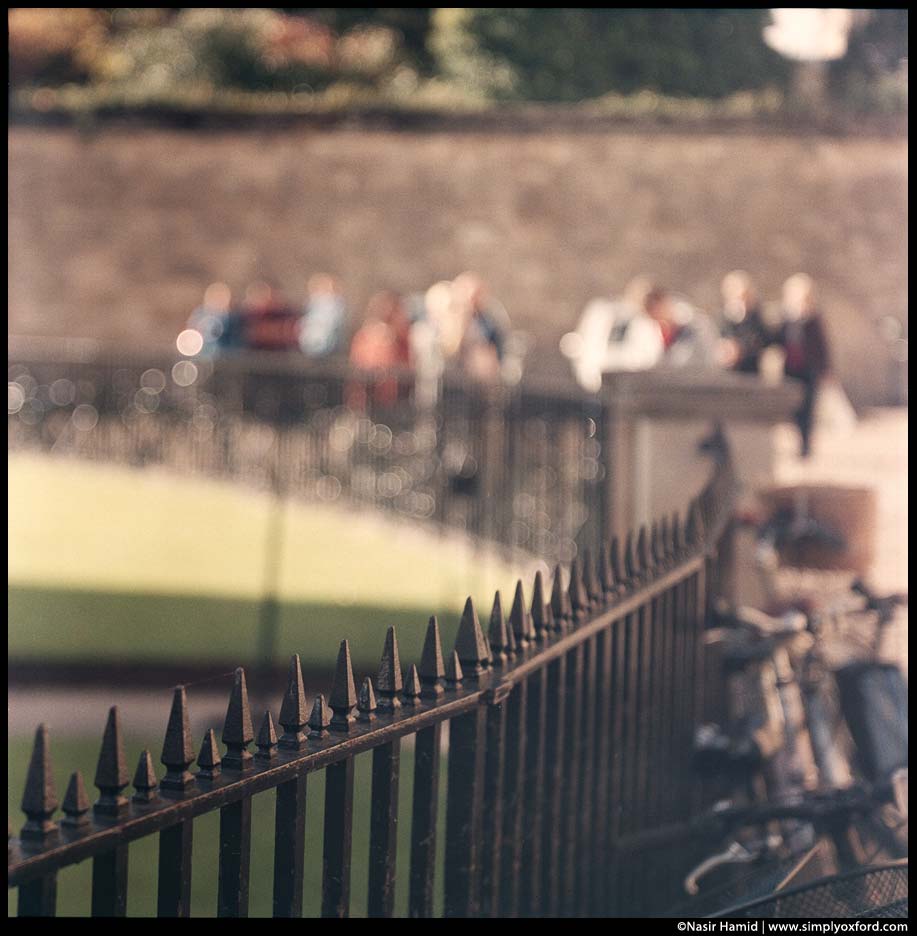
Radcliffle Camera railings
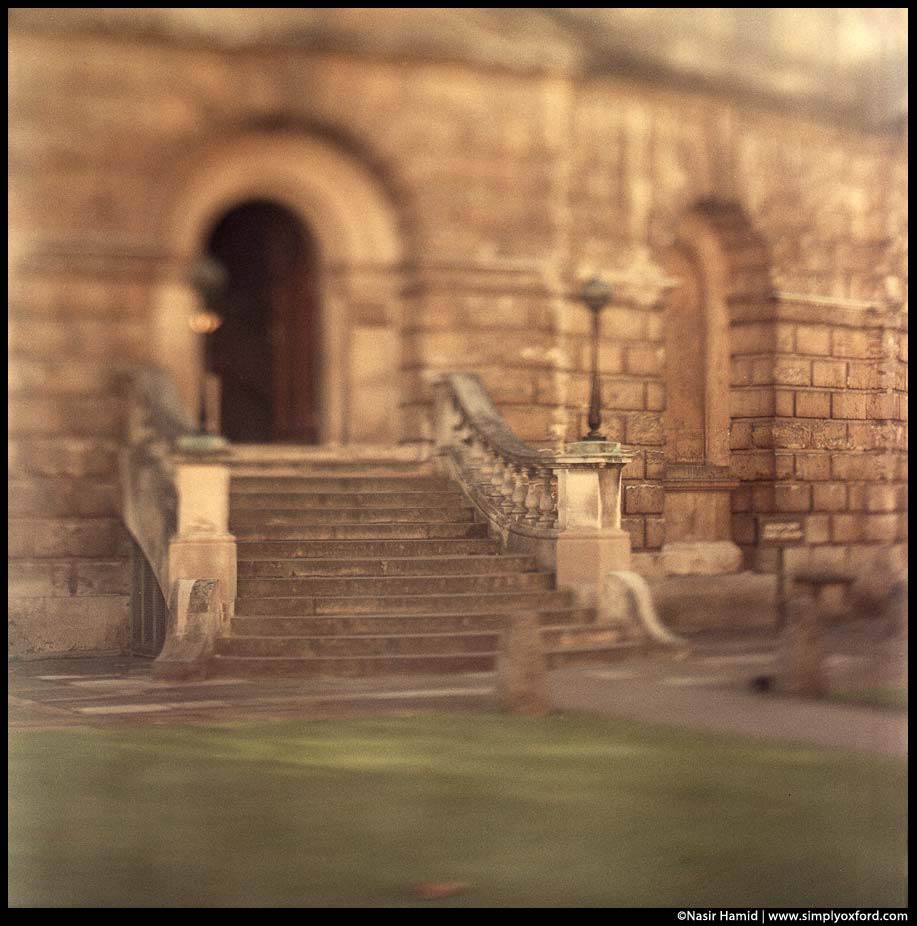
Radcliffe Camera entrance

Side of Bodleian Library
Posted in Equipment, film, Oxford | 5 Responses »
Tags: 6x6, film, freelensing, oxford, SL66
Monday, October 22nd, 2012
Recently I’ve been doing a little research into semi-stand film developing and I finally felt ready to give it a try. First I needed a roll of film to process so I shot one during a lunch hour and headed over to the darkroom after work. The film expired in 2003 so I was half expecting a bit of a fail with this experiment but despite quite a heavy base fog on the film it seemed to scan quite nicely considering the age of the film.
[Tech info:] Mamiya M645 1000s, 80mm/f1.9 lens, Kodak Tri-X (expired 2003), processed in Kodak HC110 (dilution 1:119) for 1 hour with a few gentle agitations at the 30min stage. I used 6ml of HC110 syrup to make 720ml of working developer, this is what my research suggested.
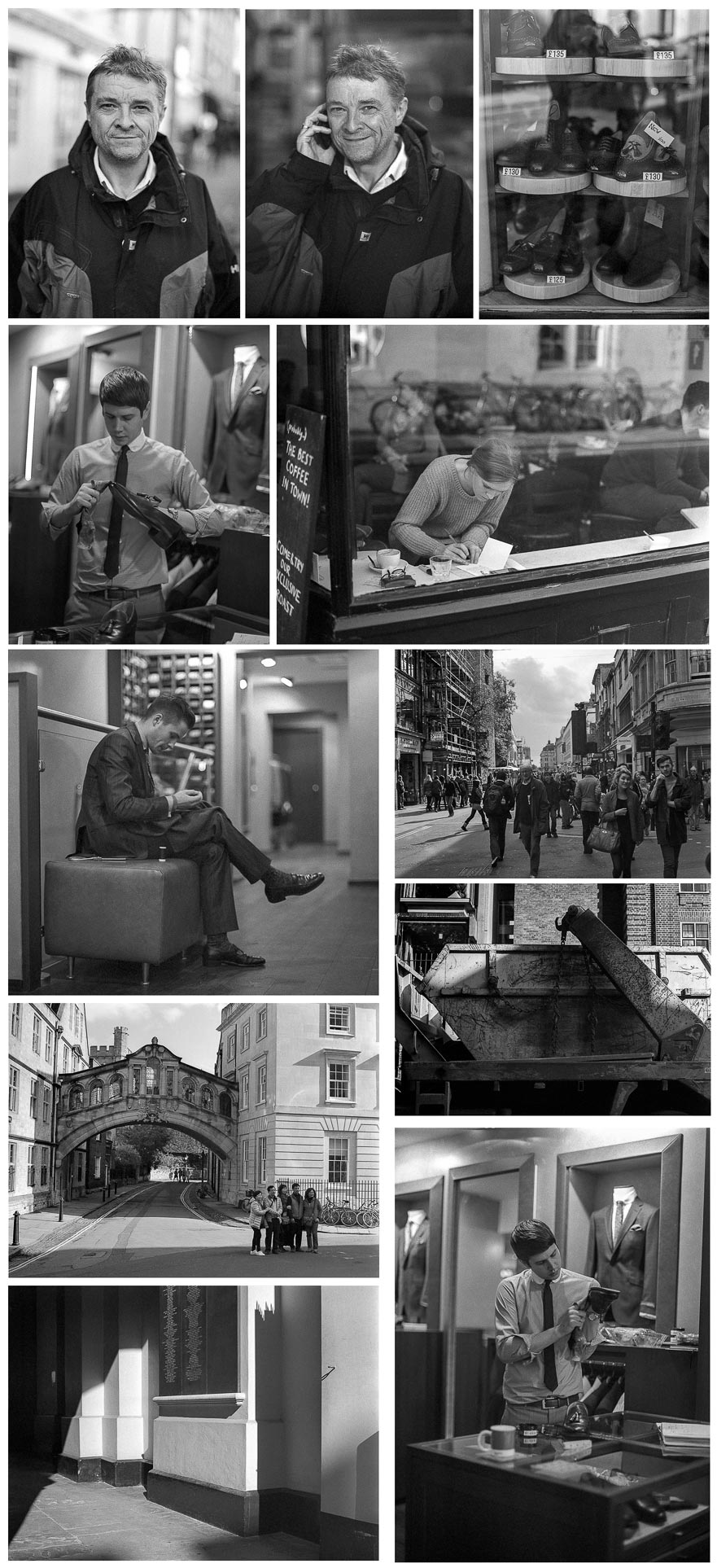
Posted in Equipment, film, Oxford, People | 1 Response »
Tags: 1000s, 645, black&white, film, hc110, m645, mamiya, oxford, people, semi-stand, Tri-X
Tuesday, July 3rd, 2012
A couple more portrait tests with large format 10×8 inch x-ray film. So far I’m very pleased with the results. I want to do some more portraits with this film so please get in touch if you’d like to be photographed.
[Tech info:] Toyo 810G, Nikon 300mm lens @ f11, green sensitive x-ray film rated at ISO 50, processed in Rodinal 1:50 for 6 mins.
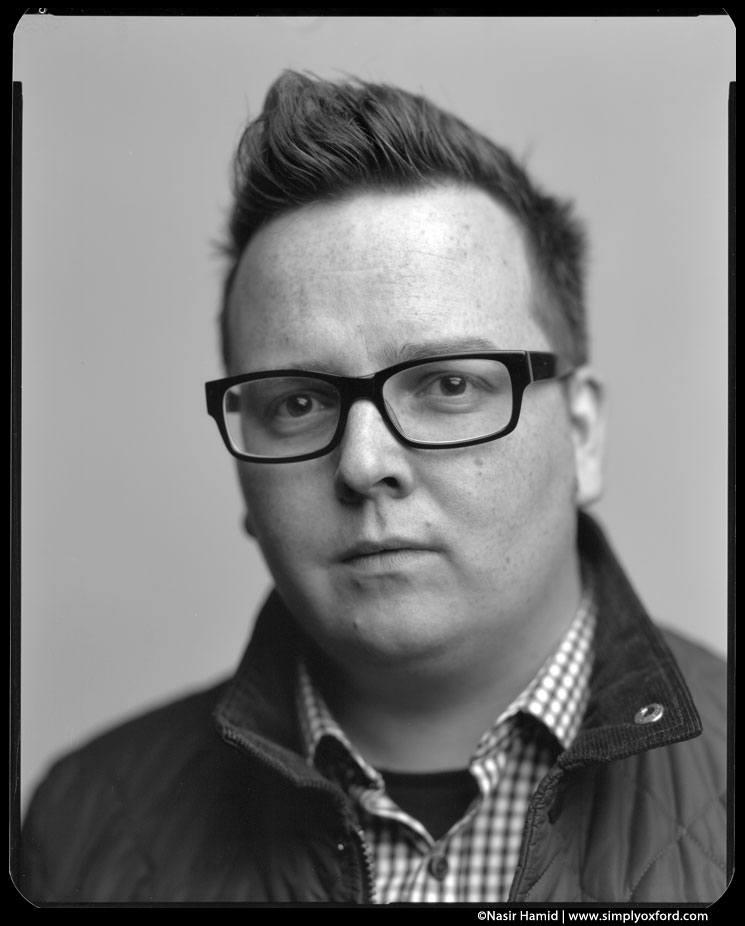
- Andy in my studio.

Andy, one light studio test.
Posted in Equipment, film, Portrait | 1 Response »
Tags: 10x8, black&white, film, rodinal, x-ray film
Friday, May 11th, 2012
This evening I spent a few hours in the darkroom making contact prints from some of my films. I’ve always loved contact sheets, there’s something about the small images that draw you in and I love the sharpness of them. I also like how looking at an entire roll of film on one sheet can help tell a story. It’s been a long time since I made any contact prints but this evening I enjoyed it so much that it’s something I’ll be trying to make time to do more of. If you’ve never been in a darkroom and seen how prints are made with nothing more than silver, light and some chemicals then you’re missing out. As I watched the images appear on the paper in the developer tray I had to remind myself of how I was making prints without the aid of a computer, scanner or printer. How amazing is that?
Low quality images courtesy of my iPod Touch.
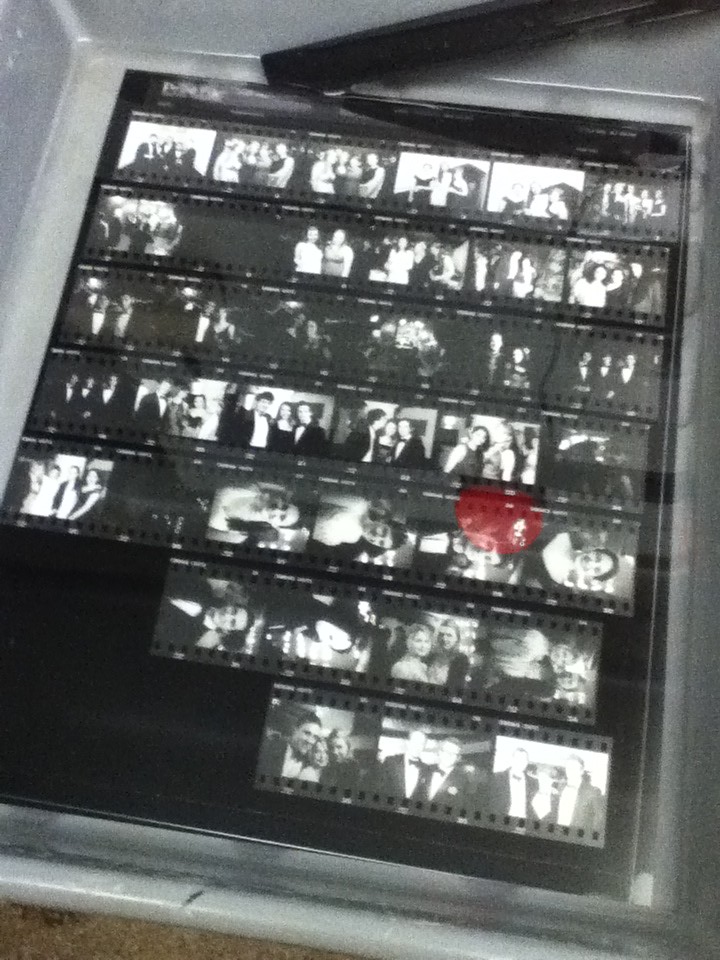
Images from the Lincoln College Ball. I haven't scanned these in yet to post on this blog.
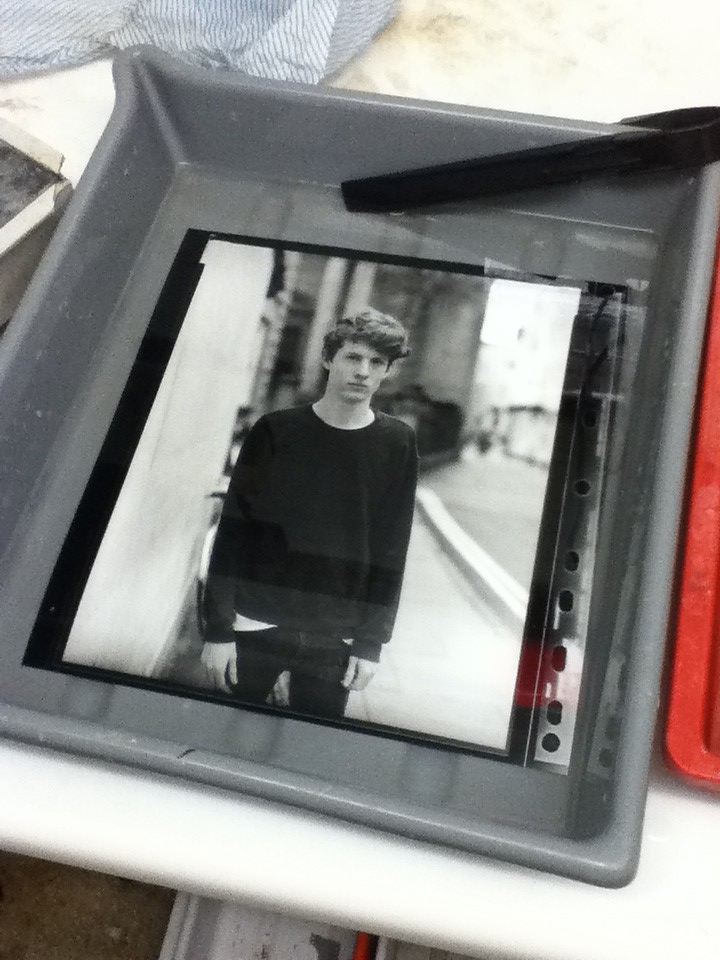
10x8 inch contact print. That's right, the negative is 10x8 inches in size.
Posted in Equipment, film, Oxford | No Responses »
Tags: black&white, film
Thursday, April 26th, 2012
I’m a huge fan of large format photography and I bought my first large format camera (a 5×4 inch Wista) back in 1990. At the time I was an assistant in a commercial photography studio where a lot of the work we did was car advertising photography for Rover which was shot on a 10×8 inch camera. The photographer I worked for has since retired from commercial photography and he’s been kind enough to let me borrow the same 10×8 inch camera that he used for all of the advertising work. It’a a big camera (four times the size of my 5×4 camera) and it’s also quite heavy. Only recently have I been able to find a rucksack big enough to hold it and last weekend I was finally able to take it out on the streets of Oxford which was lots of fun. I was only able to take 4 sheets of film with me on my outing because the combined weight of the camera, rucksack, lens and tripod all added up to quite a hefty load to be walking for 45mins into town with. I made it there and back in one piece and I can’t wait to do it again.
[Tech info:] Wista 10×8 camera with 300mm/f5.6 lens. Adox 100 film processed in Rodinal (1:50 dilution).

Here's the camera with a smaller lens than the one I ended up taking with me.
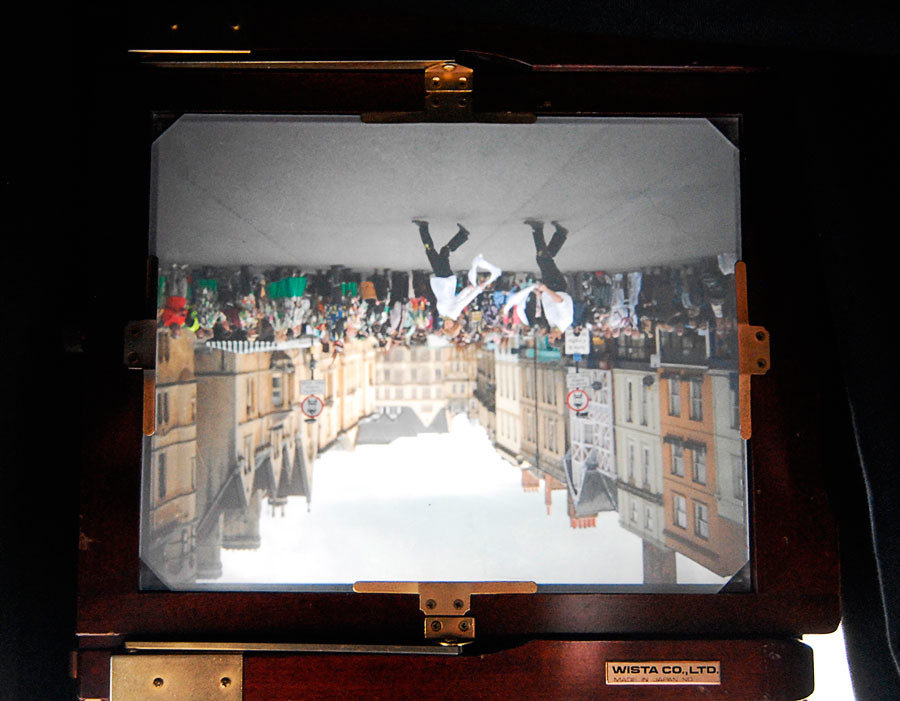
The view that I see from underneath the dark cloth. Image by Paolo Polzella.
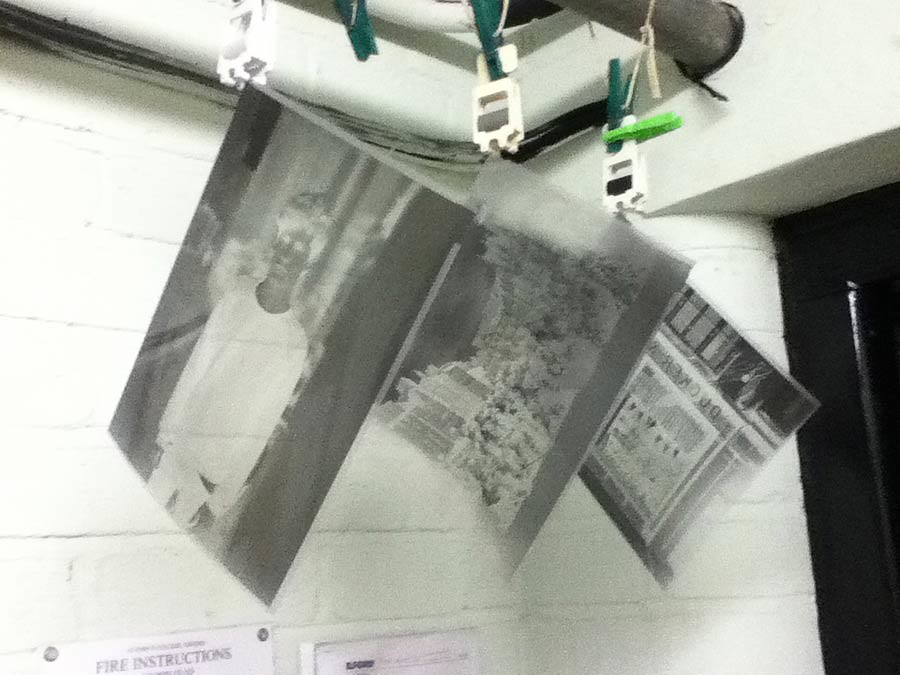
Negatives drying in the darkroom.

First shot, Turl Street, Oxford.
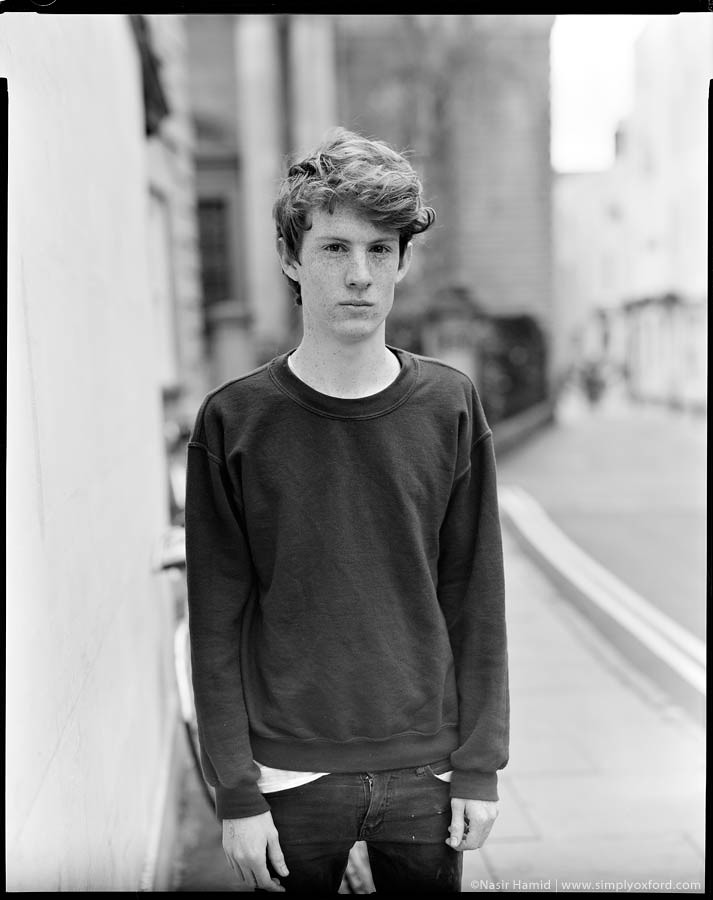
Street portrait, Turl Street. I made this shot in a hurry because this guy had to get back to work at the coffee shop down the road .
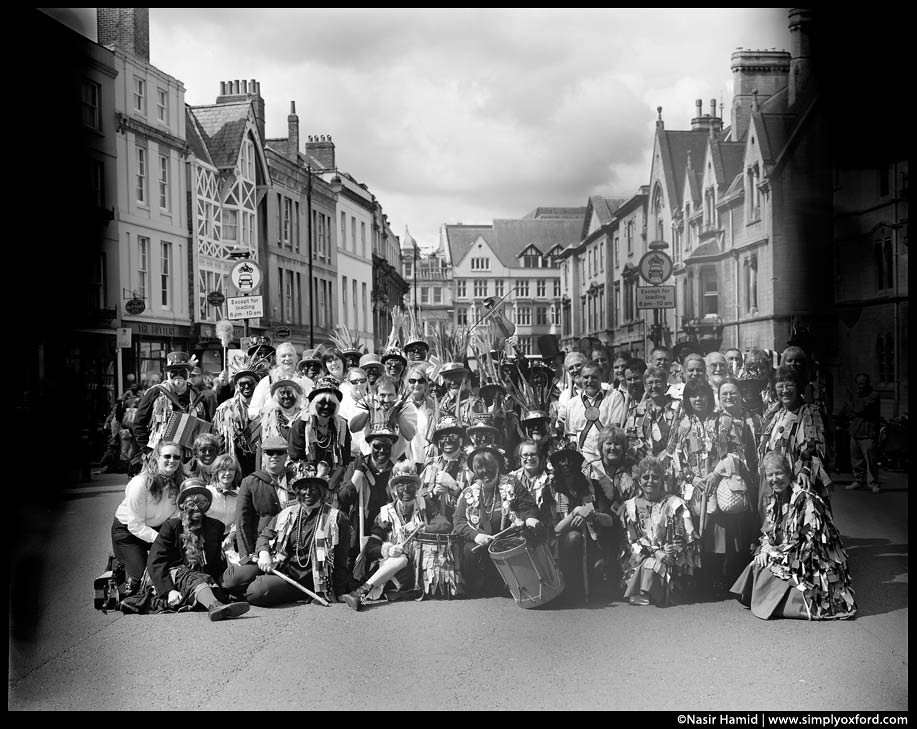
Morris dancers, Broad Street, Oxford. Unfortunately this one has a processing problem where I didn't add enough film developer to cover the sheet of film.
Posted in Equipment, film, Oxford, Portrait, Street portraits | No Responses »
Tags: 10x8, adox, black&white, people, rodinal, wista
Sunday, April 22nd, 2012
The weather forecast turned out to be wrong so instead of a week of endless rain we were fortunate enough to have some nice sunny weather during the past couple of days and when the sun is out so am I. These shots are from the first roll of film through my Rolleiflex SL66 camera. It’s similar to a Hasselblad in that it uses the same Zeiss 80mm lens design and the image format is 6x6cm square but that’s where the similarities end. In my opinion the SL66 is a lot more versatile and has features the Hasselblad can only dream about. I breezed through a roll of film in my lunch break and because this camera is lighter than most of my other cameras I was able to cover a lot more ground than I usually do when carrying heavier cameras.
[Tech info:] Rolleiflex SL66 with 80mm and 150mm lenses. Ilford HP5+ film (expired in 2005) processed in Ilford DD-X.

Rolleiflex SL66. The previous owner was a food photographer who recently retired, he used this camera for 30 years.

Going nowhere. Shop doorway, Little Clarendon Street.

James (aka Cowboy Mod). Wellington Square. You can see me reflected in his sunglasses.
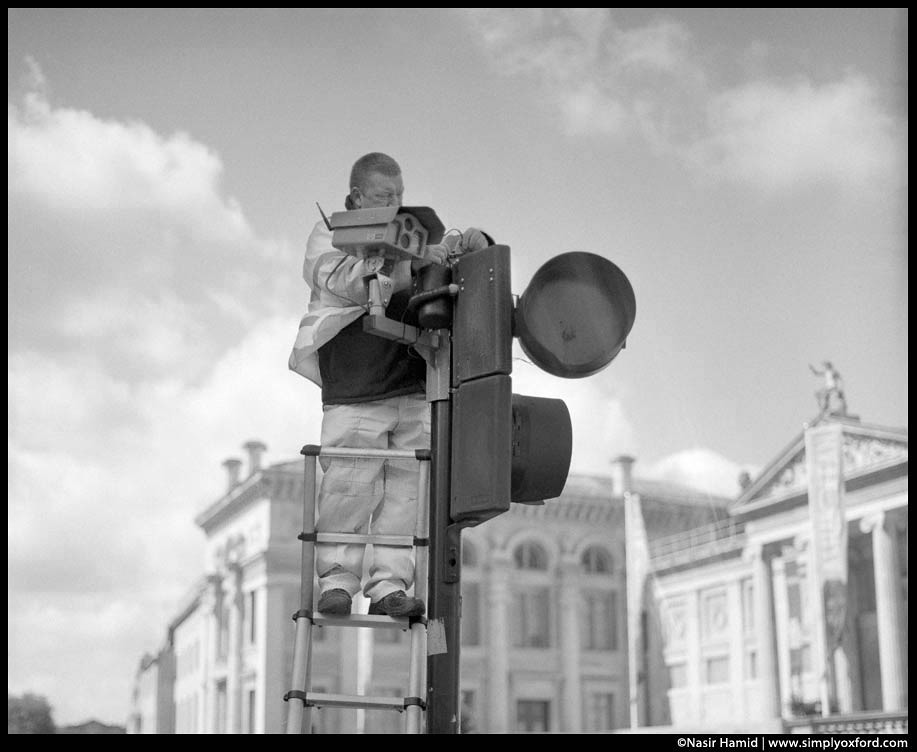
I love the way the background here looks like a painted theatrical backdrop. That's the Ashmolean Museum in the background.
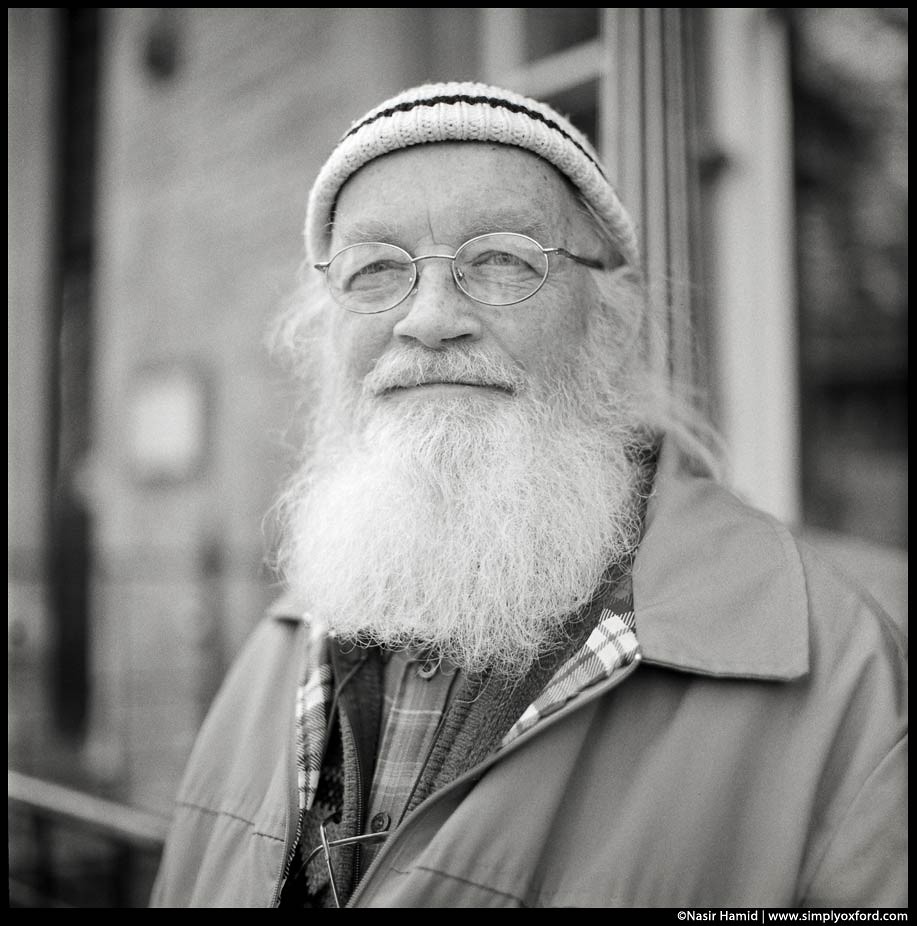
Waiting for the bus outside the Randolph Hotel. The man was very pleasant and told me he used to work in the photo trade many years ago. We chatted about photography.

Ship Street.

A quick grab shot to see how well the camera coped with moving subjects. Turl Street.

Lunchtime at the coffee shop.
Posted in Equipment, film, Oxford, People, Portrait, Street portraits | No Responses »
Tags: 6x6, black&white, HP5, oxford, people, SL66
Tuesday, April 17th, 2012
I recently bought an old Kodak barrel lens (Kodak No.33 Anastigmat 4.5 7 1/2 inch) for an insanely low price and these are some of the first test shots made with it. From what I can tell the lens is from the 1920’s or 1930’s because there’s no serial number on it so it’s certainly pre-1940’s which was when Kodak started to add them on their lenses. There’s no shutter which is where my Speed Graphic 5×4 camera comes in handy because it’s got a focal plane shutter built into the back.
So far I’ve been quite rushed when doing my tests with this lens because I’ve only had time during my lunch breaks to do any testing and so far I haven’t quite found its sweet spot yet for achieving nice bokeh. These images were all made on Fuji FP100-C instant pack film (just like Polaroid) and for a change I’ve scanned the negative after removing the black backing with household bleach. The prints look very different to these.
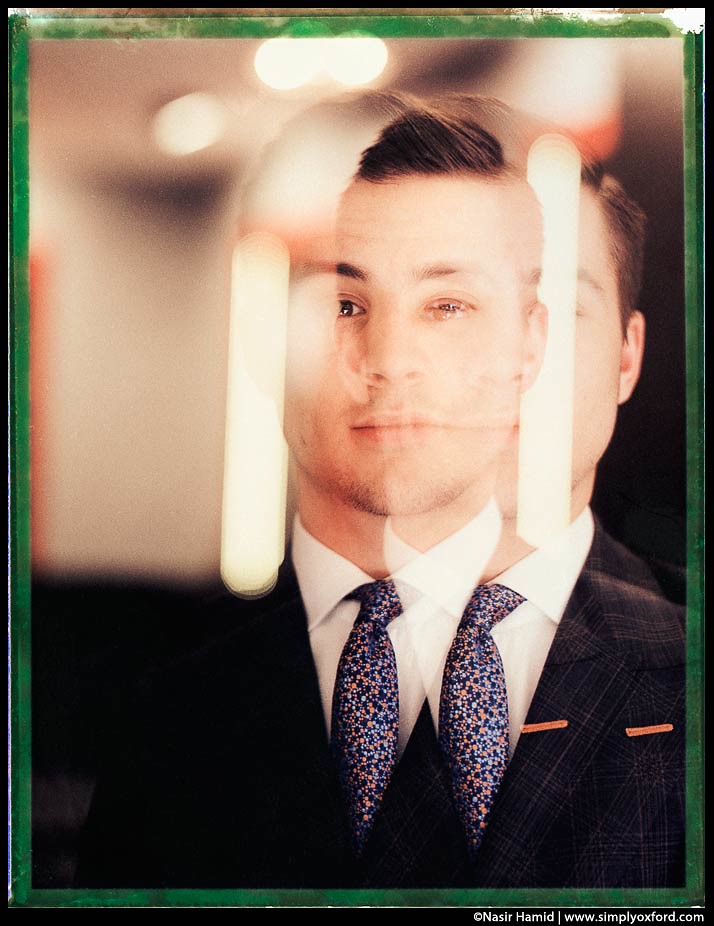
This double exposure was an accident and I was a bit gutted when I peeled the print but it's grown on me.

This is Richard who works at Clements & Church on Little Clarendon Street. It's a new men's tailor that recently opened. This shot was at least 1.5 stops underexposed but the negative seems to hold a lot more detail than the print.

My first shot with this lens. I decided to pick a subject that wouldn't move.
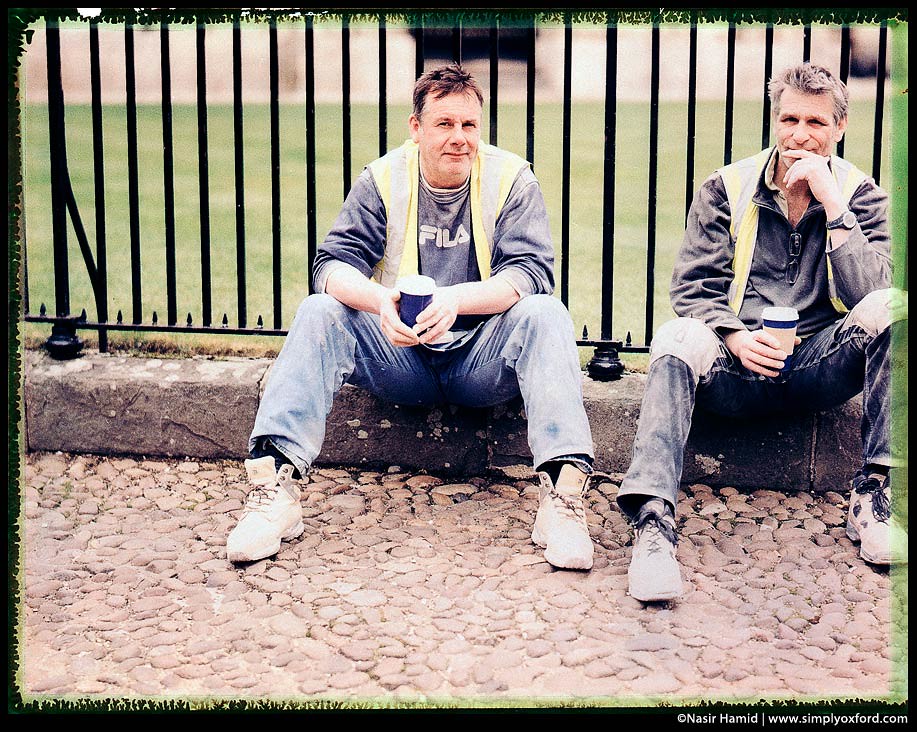
These are stone masons working on St. Mary's tower. They were very patient and we chatted about photography as I set up the shot. In my rush to get the shot I miss-framed it.
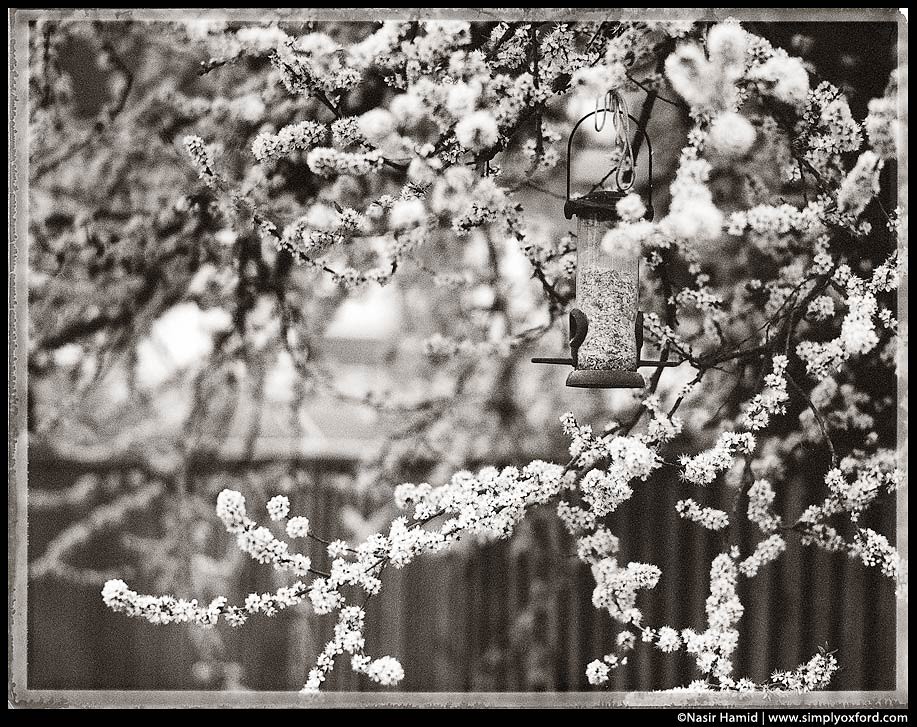
Bird feeder. Another very underexposed shot that was rescued from the recovered neg. The light level was low and I chose a fast shutter speed to freeze the moving branches.
Posted in Equipment, film, Oxford, People, Portrait, Street portraits | 1 Response »
Tags: fujiroid, oxford, people, polaroid, portraits, speed graphic
Thursday, April 12th, 2012
This is the first blog post I’ve made that doesn’t feature any of my own photography and to be honest I don’t know who the original photographer is. All I can tell you is that a box full of these glass plate negatives was on sale at a local charity shop here in Oxford and last week they were purchased by a gentleman visiting from the U.S. – he has been very generous to allow me to borrow them so that I can make some contact prints. I only borrowed them earlier today so I was keen to make some scans to see exactly what was on them.
All of the images in the box are of window displays for a tobacconist called Lewis. The name Lewis is handwritten in pencil on the outside of the box lid and some of the plates have reference numbers written along the edge as well as location information. One of them has Luton written on it. The measure approximately 6.5 inches x 8.5 inches and I can only assume that the original photographer was photographing these shops as a commercial job, commissioned by Lewis to do so or it was a personal project. It makes me a little sad to think of all of the work that went into making these images however many decades ago and they end up being donated to a charity shop.
Many thanks to Ken for the loan of these glass plates. I really enjoyed scanning these and I look forward to making some contact prints from them in the coming weeks.
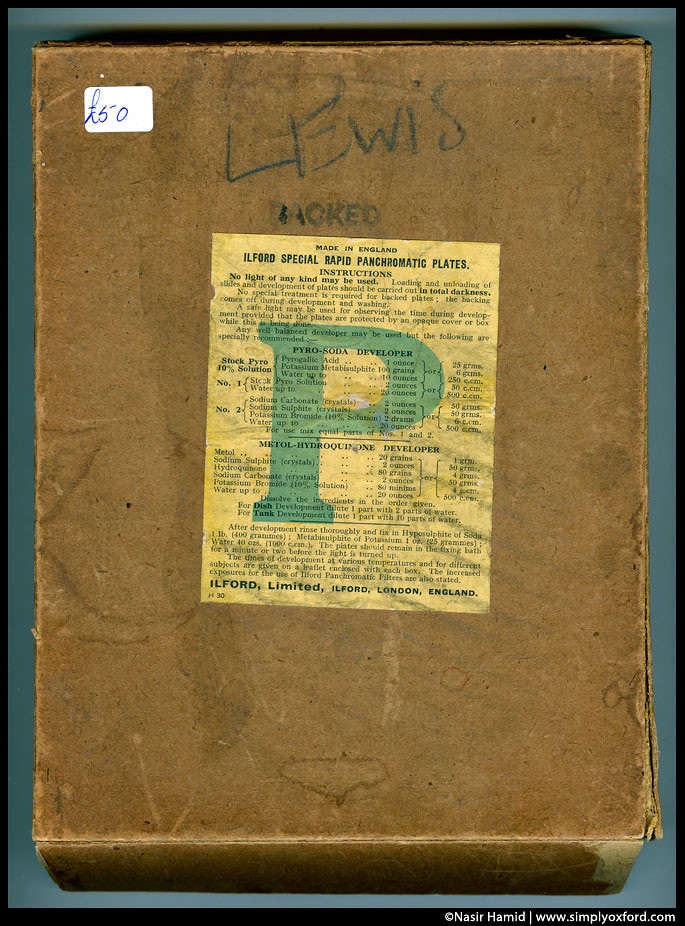
The lid of the box the glass plates were in
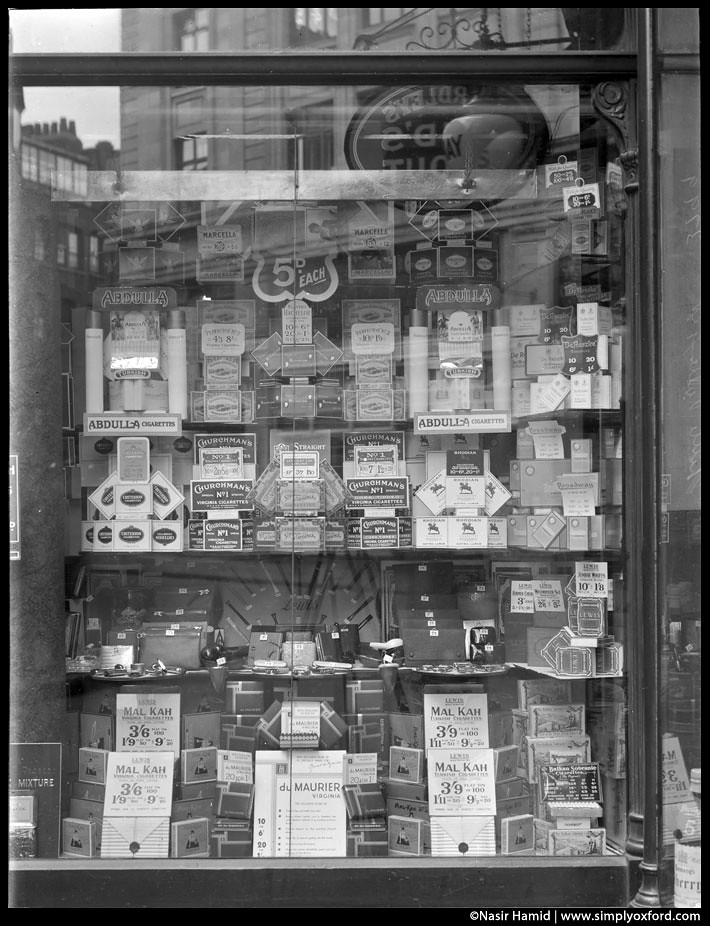
Shot 1
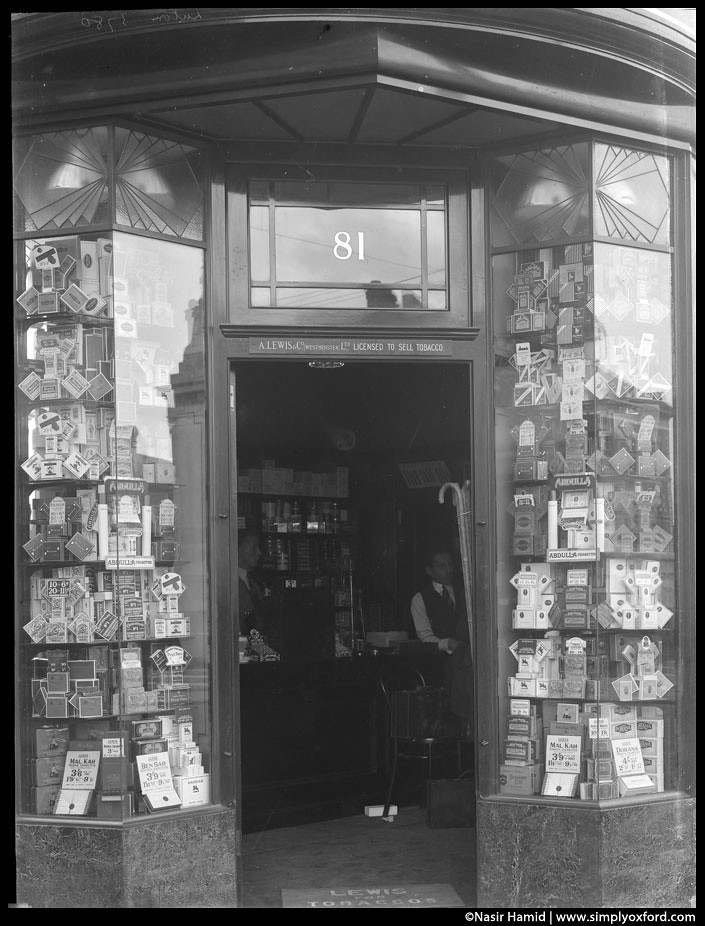
Shot 2. The exposure time for this shot must have been quite slow because there is motion blur from the men inside the shop

Shot 3
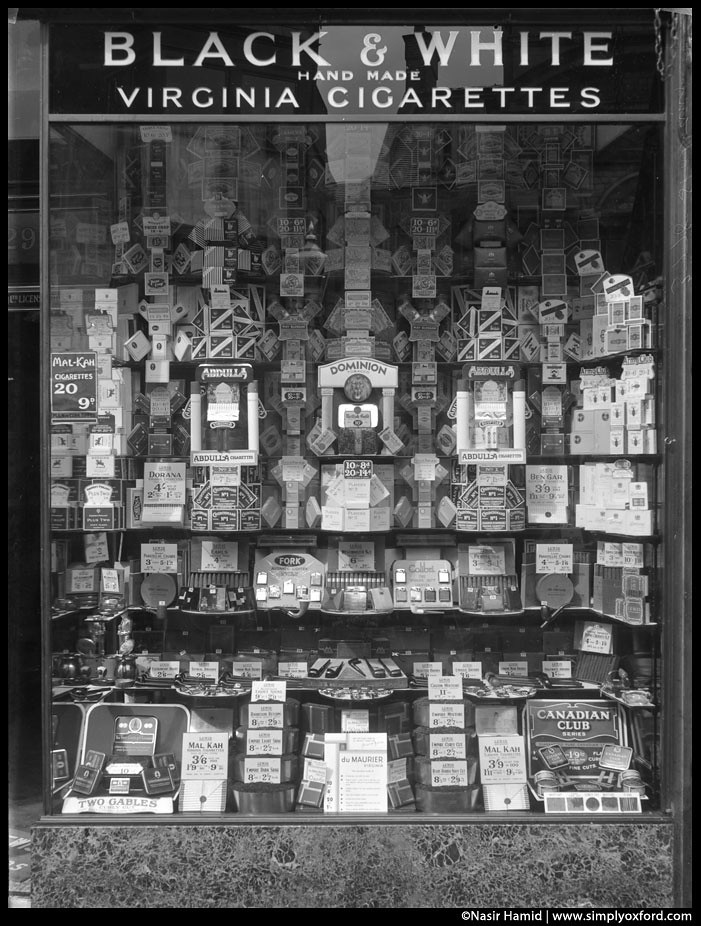
Shot 4
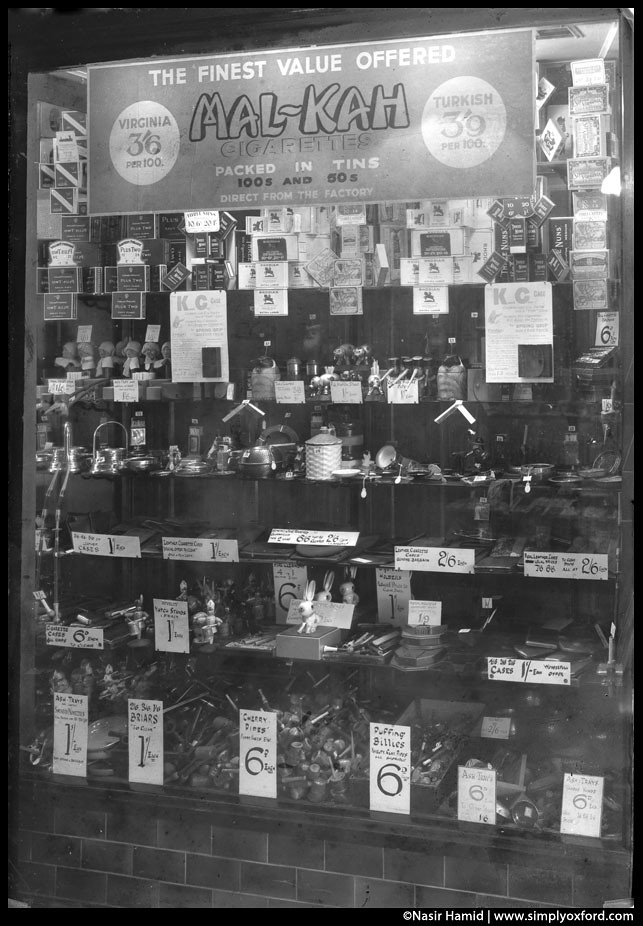
Shot 5
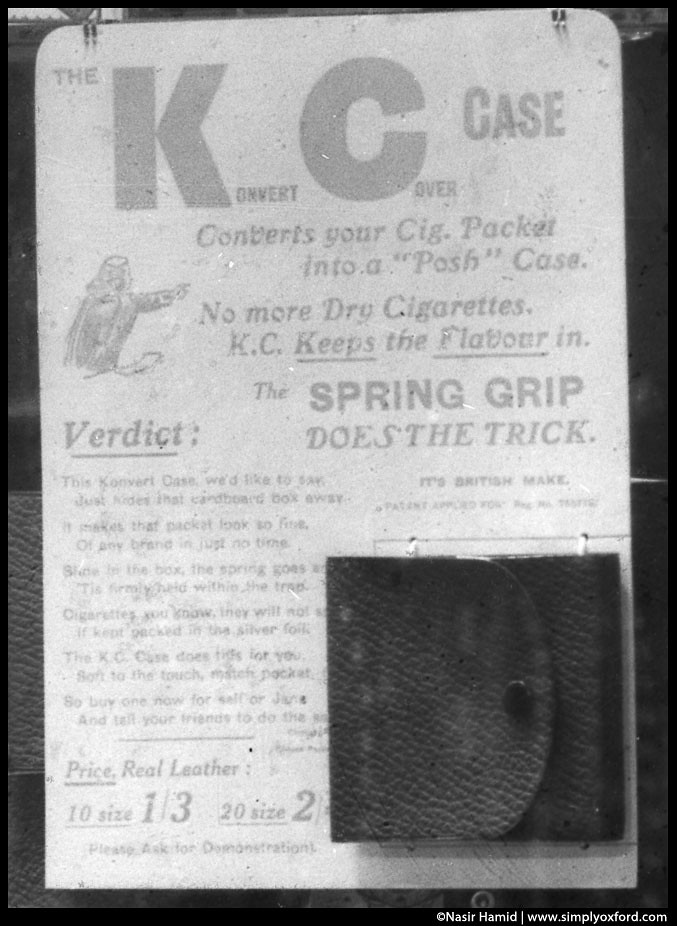
To show how detailed these images are, here's a crop of a small part of this image that's less than half the full resolution of my scanner
Posted in Equipment | 4 Responses »
Tags: glass plates, vintage
Wednesday, March 21st, 2012
These two images were made with a Kodak Aero Ektar lens on my Speed Graphic 5×4 large format camera. The lens was designed for aerial photography during WWII and it’s quite a chunk of glass. Here’s a picture of the setup: http://www.simplyoxford.com/equipment/equipment-aero-ektar
I’m still getting to grips with how best to make use of the shallow depth of field you get with this lens but so far I think it’s a good start.

Broad street & Catte street junction. This film is Ilford XP2 (expired).
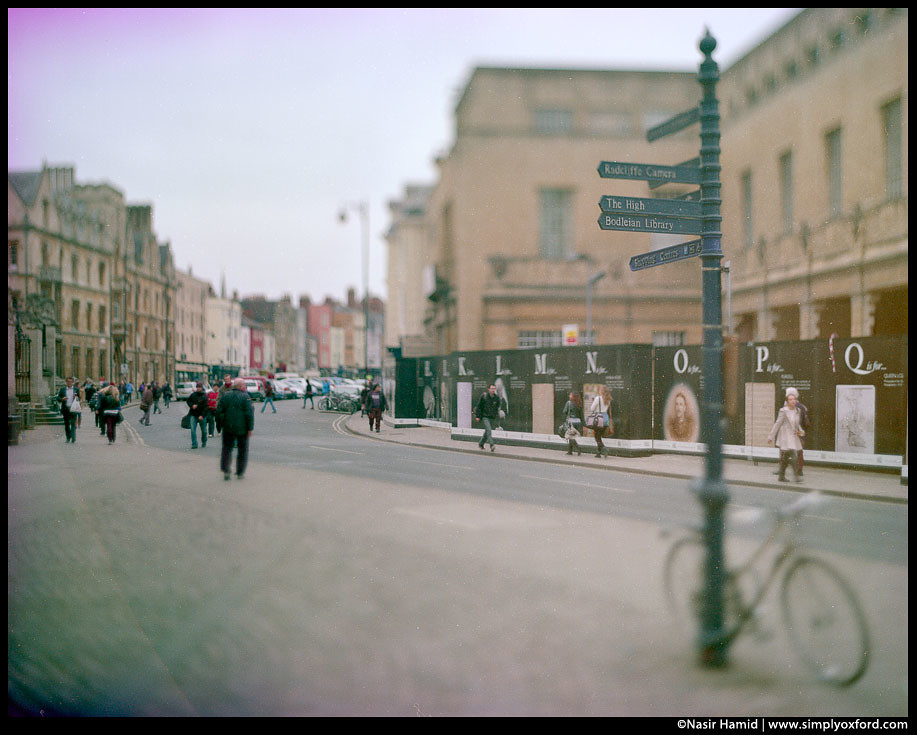
Broad street. This film expired in 1991. I bought a job lot of it so I'm pleased with this result.
Posted in Equipment, film, Oxford, People | 1 Response »
Tags: 5x4, black&white, people
Tuesday, February 14th, 2012
Here are some shots from the second roll of Ilford P4 Surveillance that I’ve tried out so far. I think that all of the rolls that I have left from this batch will be damaged like this. The film seems quite old and may have been poorly stored but I quite like the aged look so I don’t mind too much. These shots are very different from my usual style but I very much enjoyed a more ‘shooting from the hip’ snap shot approach here.
[Tech info:] Nikon FM2, 50mm/f1.4 lens, Ilford P4 Surveillance film processed in Kodak HC-110 dilution B (1:31), 9mins at 20C.
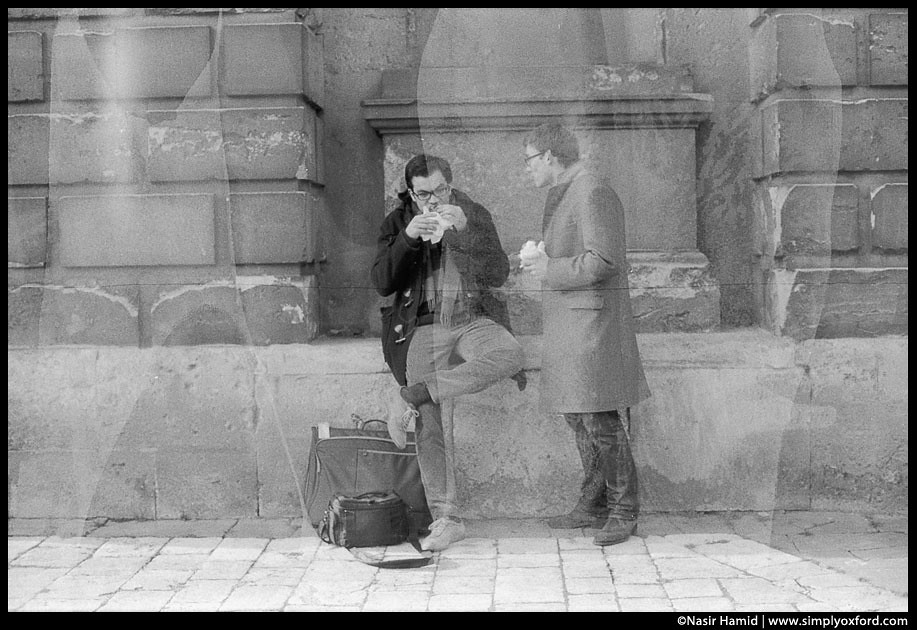
A bite to eat.
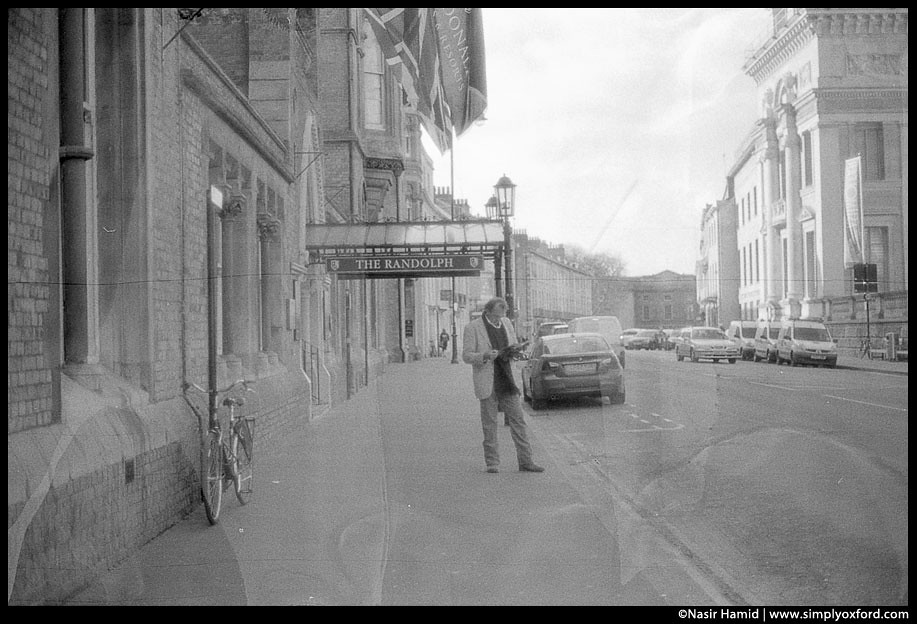
Outside The Randolph.
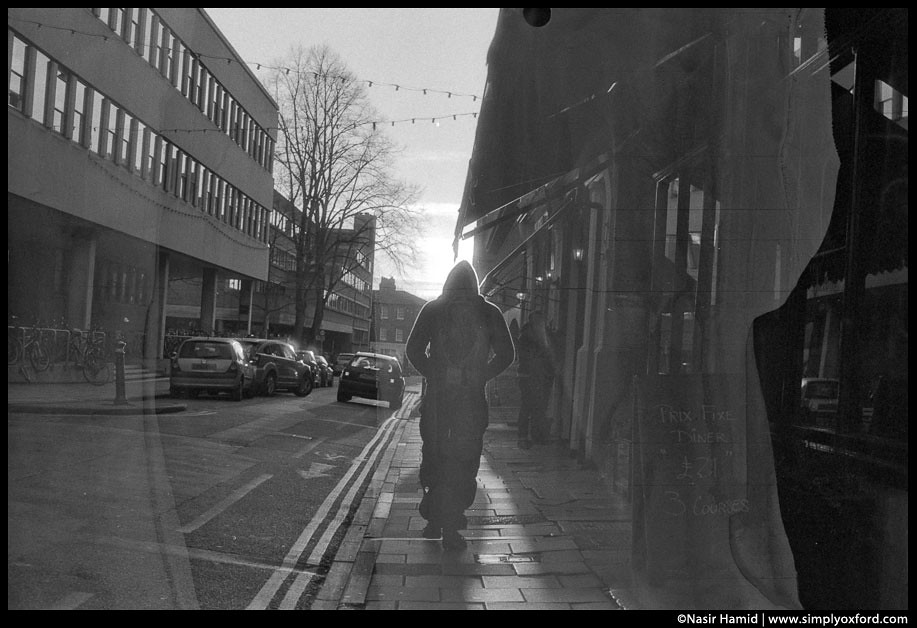
Rim light.
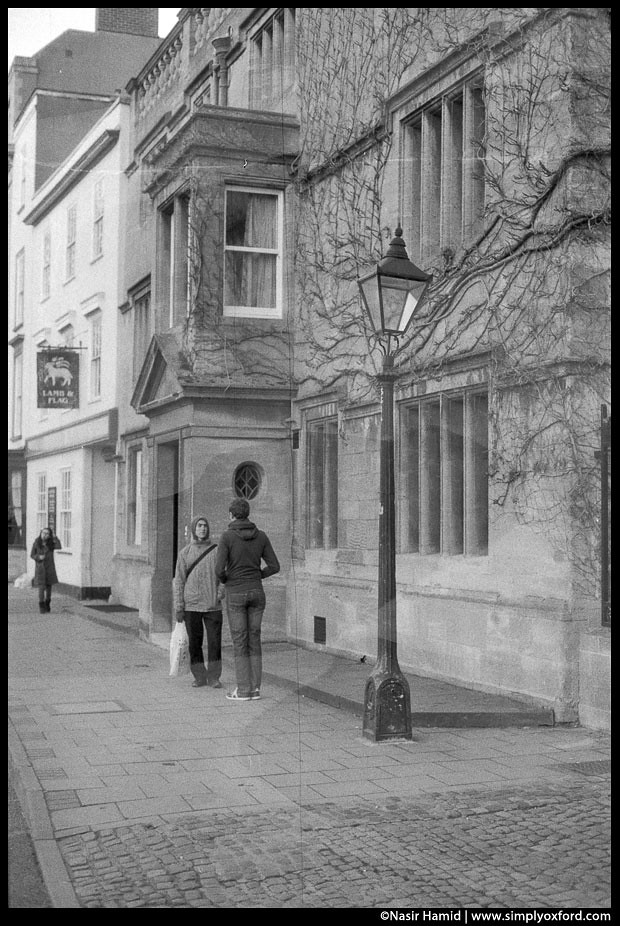
Standing still, St. Giles.

A sign of Spring? Wellington Square. I pass this tree every day but this was the first time I noticed these hanging around.
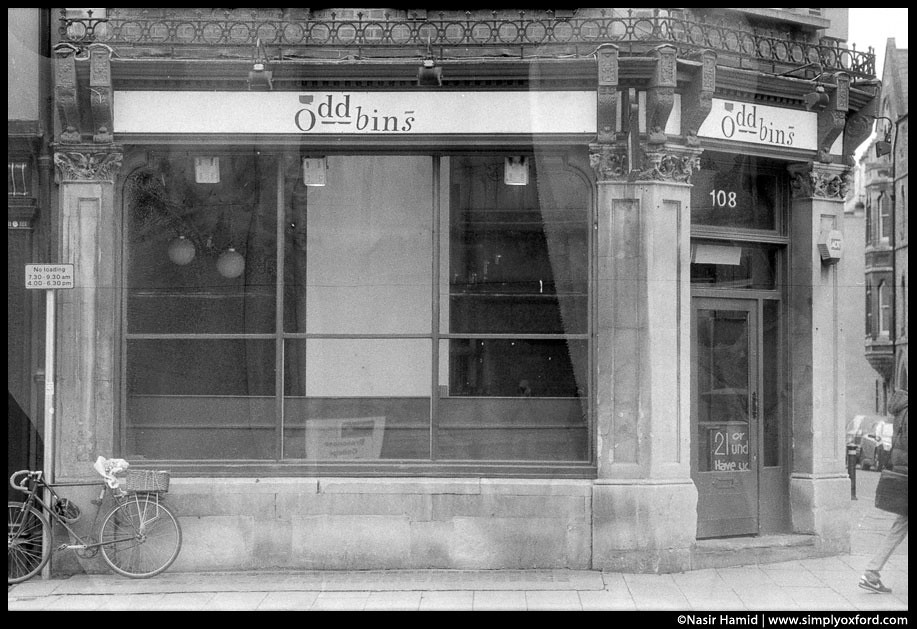
Oddbins off licence, closed after 40 years on the High Street.
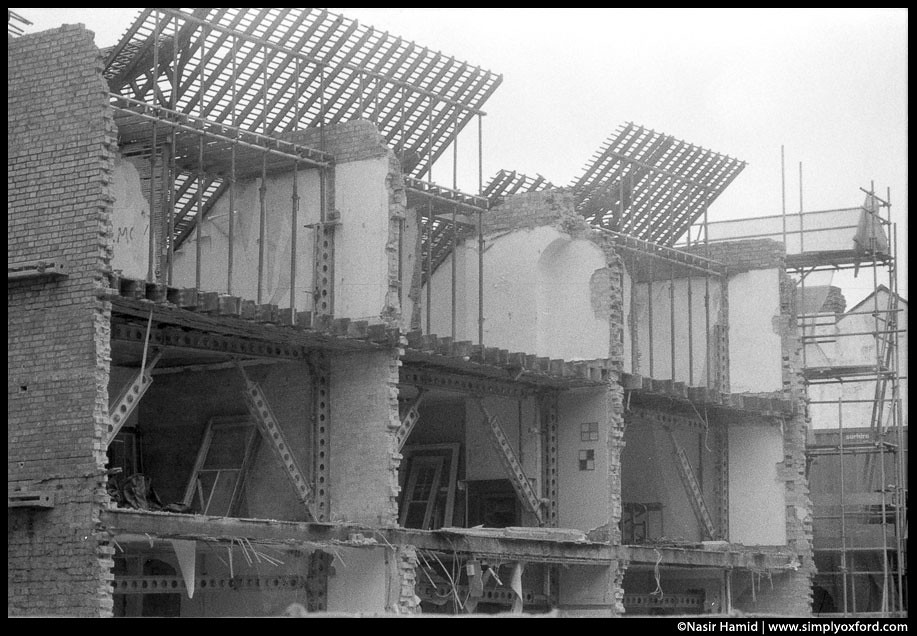
Walton Street building project.
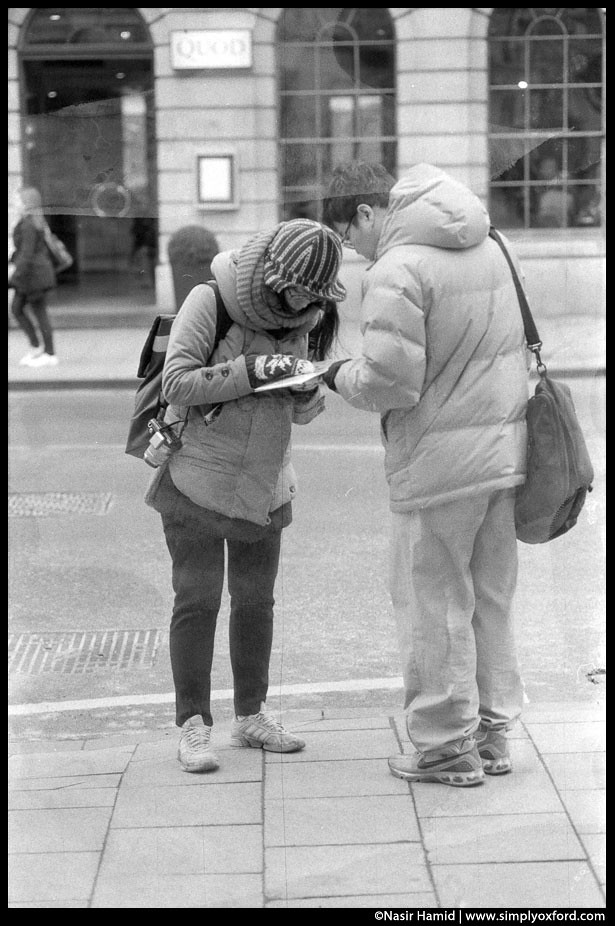
Map reading.
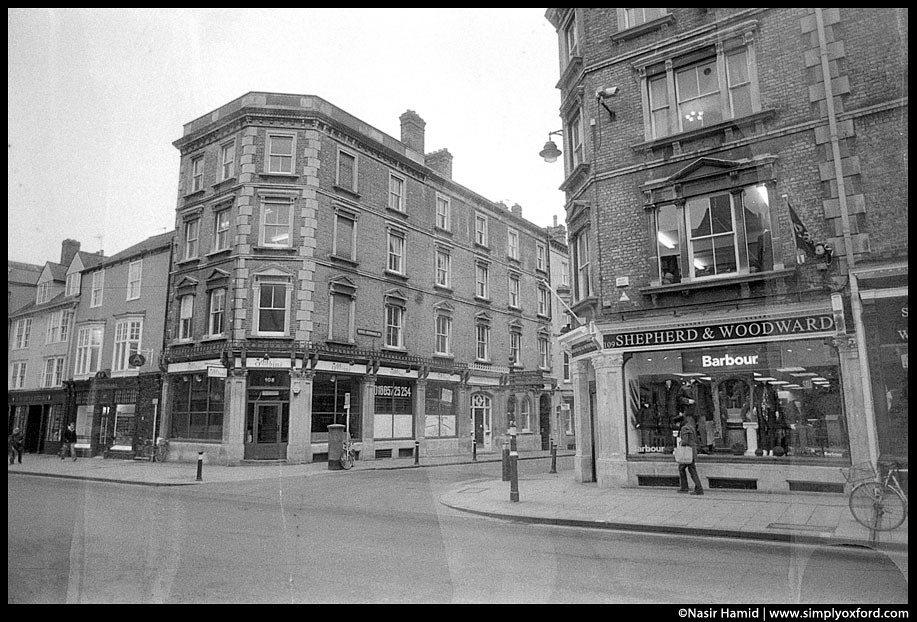
High Street shops.
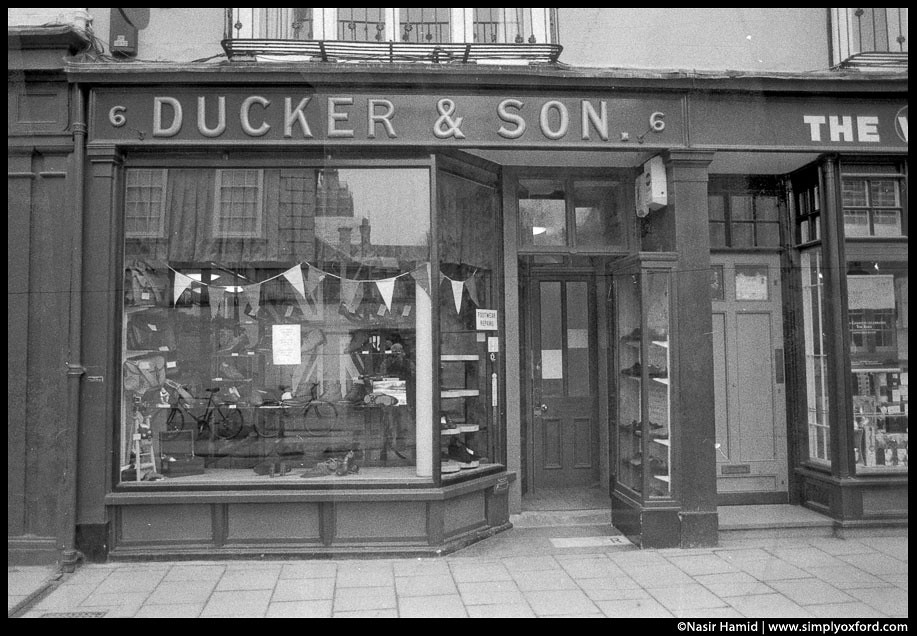
A nice old shop front on Turl Street.
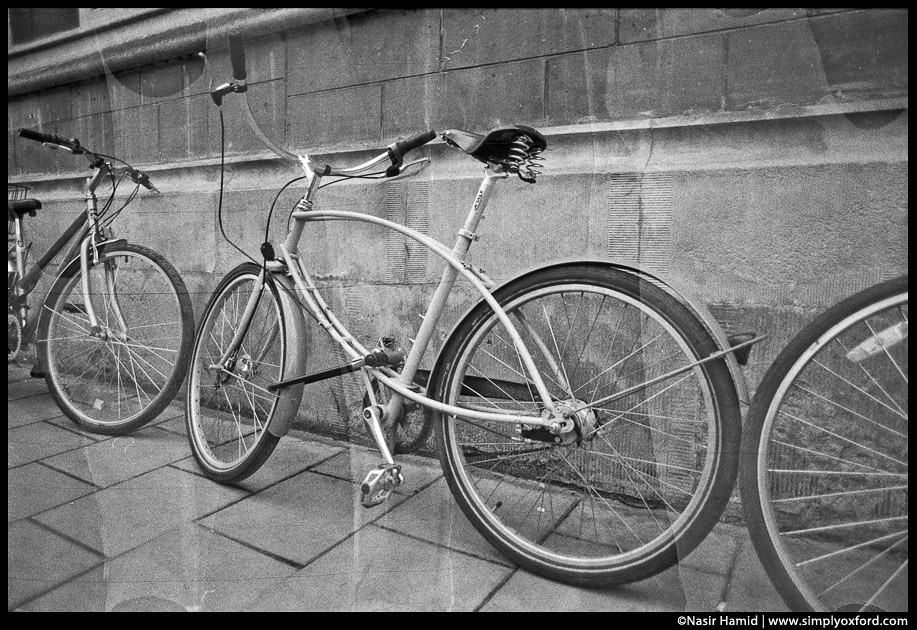
I like the shape of this bike frame and the seat looks nice and comfy.
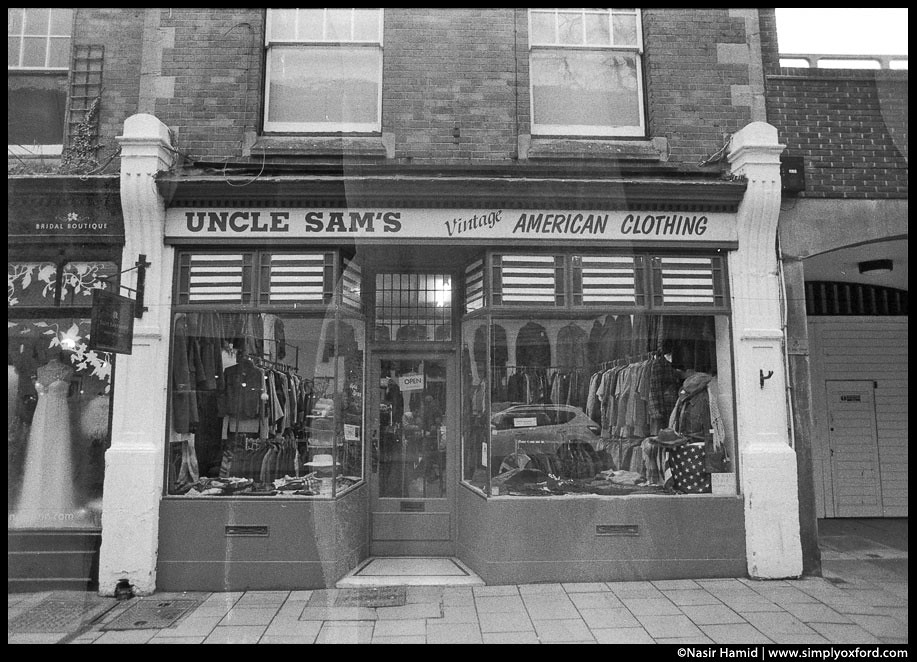
Clothing shop, Little Clarendon Street. A nice shop front.
Posted in Architecture, Equipment, film, Oxford, Street portraits | No Responses »
Saturday, February 11th, 2012
Recently I bought a job lot of film from someone on a well known auction site and among the different brands of film was some that I have never heard of, Ilford P4 surveillance. A little research pointed to it being used in traffic cameras and for surveillance (doh!) work. The film I received had been individually loaded into cassettes from a bulk roll, the empty box of which was included for me to read more information. I don’t know if the film I received was from the empty box because the expiry date on the box was 2010 but after processing the first two test rolls I noticed that one of the layers of film above the emulsion had come away in patches which is why these scans look uneven. There are also scratches across the film which points to grit in the felt trap of the cassette. I did rattle these shots off as a test so I don’t mind too much and I’m thrilled with the look of this film so it’s okay.
The thing that amazes me the most is the dynamic range this film is able to capture. I deliberately used it in situations where I know other films would struggle which is strongly backlit shots. The contrast is flatter than ‘normal’ black & white films and for an ISO400 film the grain is quite pronounced but I do like it. I’ve got lots more of this film to use for testing so more images will follow. These shots were made with my very first SLR camera that I bought in 1987 and although I probably haven’t used it in maybe 15 years the battery for the light meter still has power in it and I enjoyed using this camera more now than I ever did. Apart from the light meter the camera is completely mechanical and that’s partly why I love it so much. It will function without a battery and is totally manual – which roughly translated means you need to know what you’re doing because there’s no ‘P for Professional mode’ to help you.
[Tech info:] Nikon FM2 with 50mm/f1.4 lens loaded with Ilford P4 surveillance film. Processed in Kodak HC110 developer (dilution B 1:31) for 10mins at 20C.

Nice bike. I love the dated look of this shot.
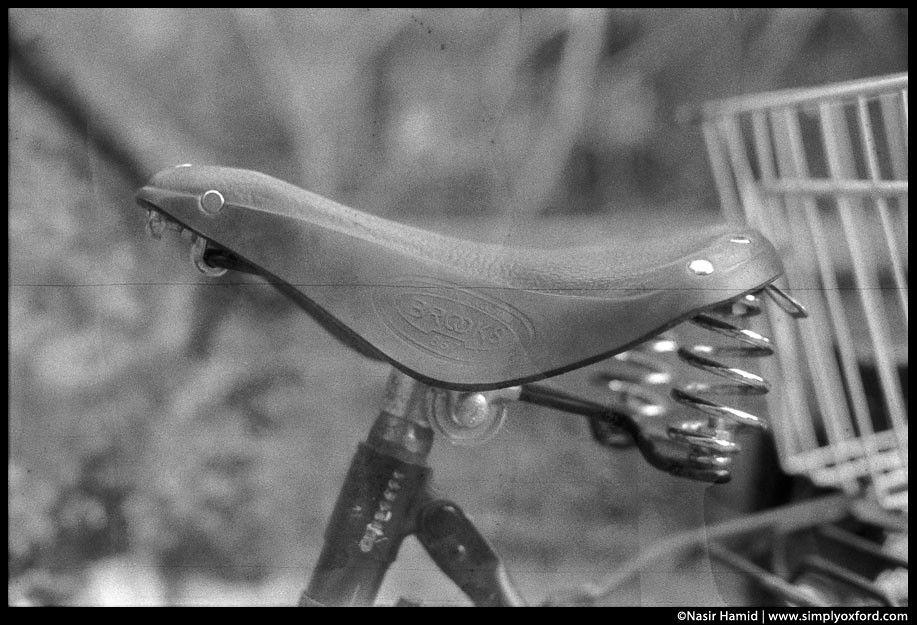
Brooks saddle.
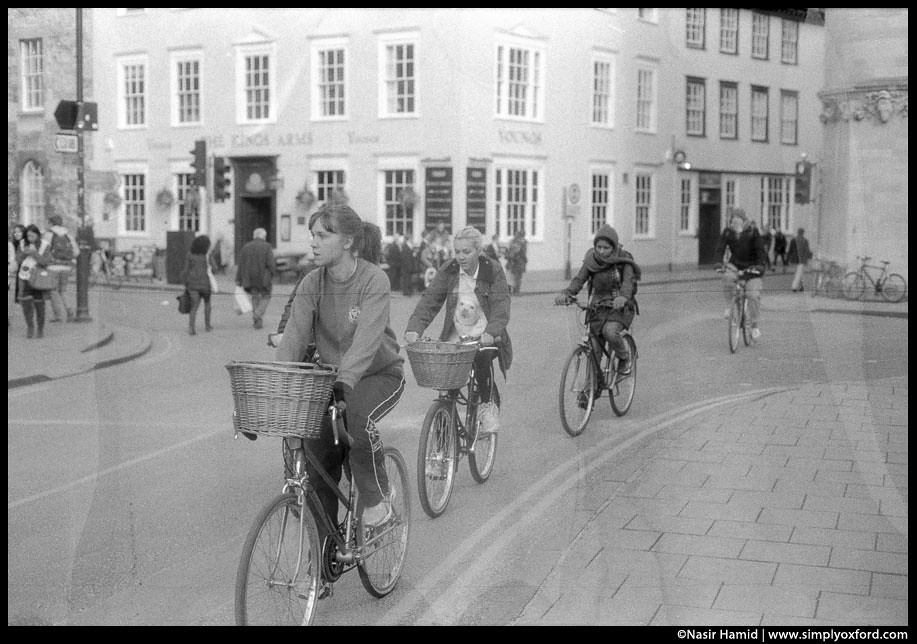
Broad street cyclists.
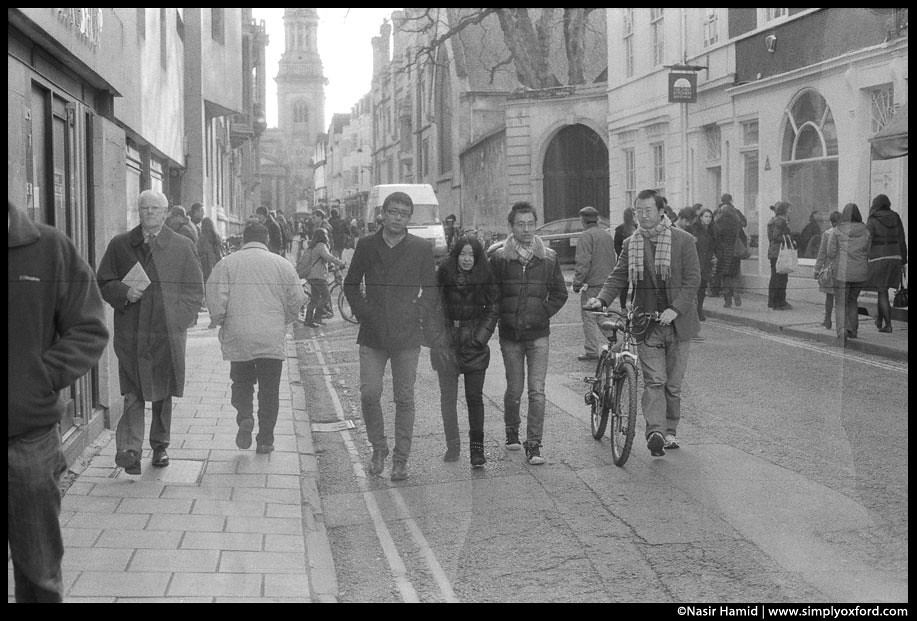
Turl street.

This pub was a favourite of JRR Tolkien and his pals.
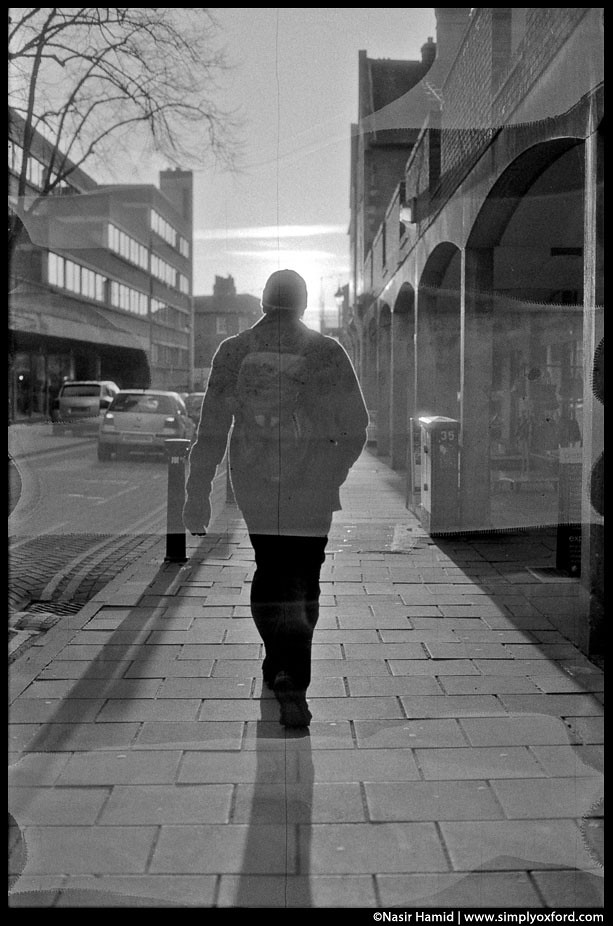
This image is a great example of the incredible dynamic range of this film. This man is walking directly towards a bright setting sun. The contrast in the scene was so high that all I could see was a silhouette but on film you can clearly see his rucksack and there's still plenty of detail in the sky too.
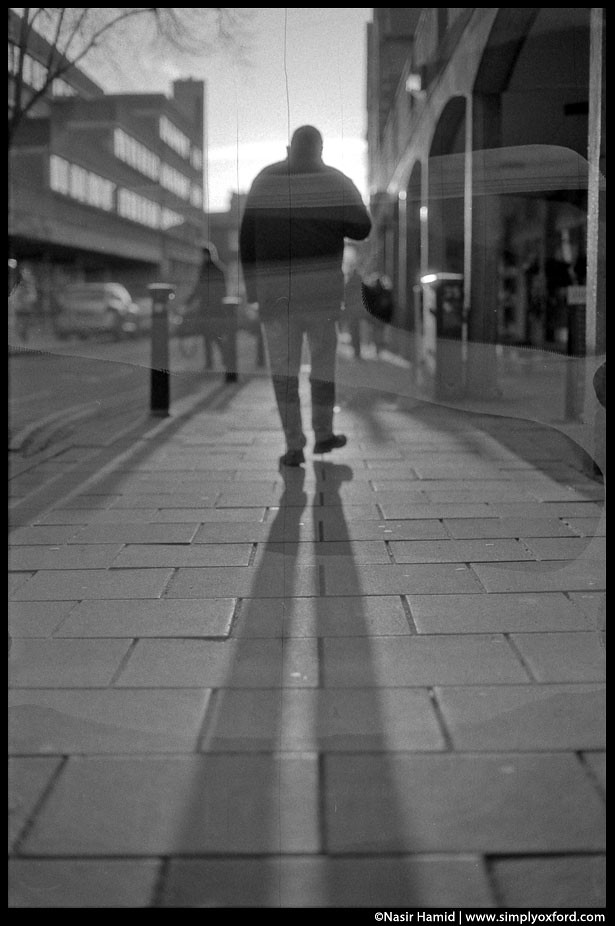
Long shadow.
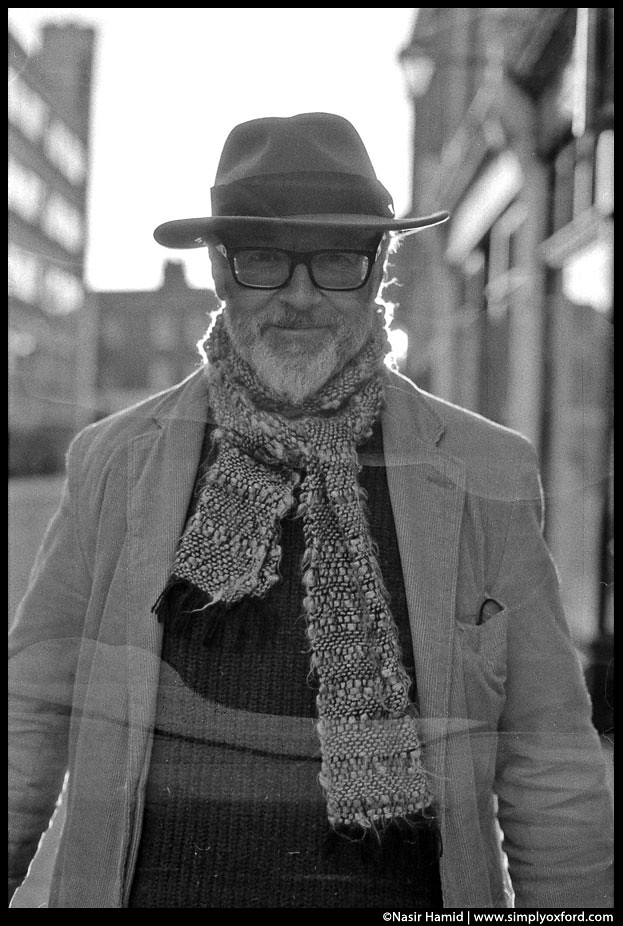
Another great example of a backlit subject by the setting sun. All I saw was a silhouette through my viewfinder.
Posted in Equipment, film, Oxford, Street portraits | 2 Responses »
Saturday, February 4th, 2012
Sometimes the most photogenic still life objects are closer than you think. This red pepper had been sitting on our kitchen worktop for a few days before I noticed how perfect it would be for a photograph. I wanted to compare the difference between the multigrade paper negatives I’ve been producing recently and some Polaroid instant pack film. The Polaroid expired in 2004 and although it’s meant to have an ISO of 100 I’ve found that it’s actually now ISO 50. The paper negative is Ilford multigrade glossy rc paper with a grade 2 filter on the camera lens.
[Tech info:] Wista 5×4 with 150mm lens.

Paper negative

Expired Polaroid 664
Posted in Equipment, Still life | 4 Responses »
Tags: 5x4, paper negative, pepper, polaroid, still life, wista


























































